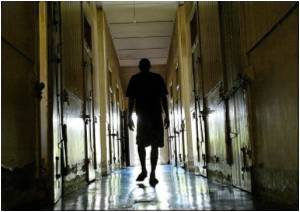Living space is at a premium in big cities and the Philippines is no different.

The poor and the dead have little choice but to mingle together in a graveyard in the northern Manila port district of Navotas, one of the world's most densely populated areas behind only a few Indian cities.
"We would like to live elsewhere," Ramos, a 20-year-old pregnant, unwed mother of two, told AFP as she fed her children inside a shanty made of plastic sheets, bamboo and bits of wood.
"But we were born here and we grew up here. I don't think we will be able to get out of here."
Ramos's tent is one of several pitched precariously atop a row of concrete tombs, themselves piled five-high, like shipping containers, at the crowded Navotas municipal cemetery.
Ramos and her extended family of 12, plus her jobless boyfriend, are one of about 600 families in the cemetery compound, a community ironically called Bagong Silang (Newborn).
Advertisement
There are no toilets or running water, garbage piles up among the tombs and the area is infested with cockroaches that particularly like to parade across the tombs at night.
Advertisement
Jerry Doringo, spokesman for the Novotas city government, explained that local residents got free burial when they died, but the corpses could only stay inside the tombs for five years.
"After that they have to make way for the new arrivals," he said.
Life for the cemetery's residents, however, is not completely grim.
At sundown, bare-chested men play basketball, karaoke echoes past the tombstones and children amuse themselves by climbing up the tomb decks or flying kites.
"Sometimes they play with the skulls," Ramos said of her children.
And while she said there were no ghosts in the graveyard, her younger brother, 16-year-old high school student Marcelo, insisted with a smile that there were.
"There's nothing to worry about! If a ghost comes, we just swear at it," he said.
Marcelo said that, aside from ghosts, the community also at times had to deal with "aswang", a witch-like woman of local folklore who grows bat wings at night and detaches her upper body to go and suck the blood of sleeping humans.
"Sometimes there are aswang... we've had aswang here before. One bit my niece," he said.
However, laughing and smiling, he said his niece recovered from the witch's bite and was living a healthy life.
In a nation where a third of the population live on a dollar a day or less, millions of Manila's poor stay in sprawling shantytowns, their flimsy houses sitting on swamps, under bridges, and atop open sewers.
Doringo pointed out that Novotas was not the only city with a cemetery full of squatters.
He said the city government has bought a lot south of Manila that would relieve Navotas of some of its squatter problems, but he conceded its facilities were not be enough for all of Bagong Silang's current residents.
Also, the cemetery dwellers would prefer to live among the tombstones than in an area further away from the port where employment, albeit low-paying, was much harder to find.
Grade-school teacher Juliet Verzosa said many of the people living in the cemetery were poorly educated migrants from the island of Samar, one of the country's poorest areas.
They work as porters at the Navotas port or public market, take other odd jobs, or fish using small canoes, said Verzosa, who lives outside the cemetery but has been helping its residents for more than 15 years.
On the day AFP visited, grieving housewife Rosita Pontanes lit a candle in front of a deck of tombs that contained the remains of her mother, interred earlier that day.
Pontanes, a Roman Catholic like most Filipinos, told AFP she did not resent the seeming desecration of the dead by the squatters.
"She (her mother) will understand," said Pontanes, who lives outside of the cemetery. "They deserve our pity as well. They have no place else to go."
She was more concerned about her mother's remains, which she knew would eventually be dug up.
Source-AFP









